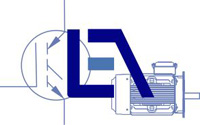Villwock
Dr.-Ing. Sebastian Villwock
"Identification methods for the automated commissioning and condition monitoring of electrical drives" (2007)
The present work deals with the automatic commissioning and condition monitoring of the mechanical system of electrical drives and consists of two main parts.
In the first part an identification method is developed, which is applied to two- and three-mass-systems without backlash. The identification is carried out in two steps: First the frequency response is calculated by processing the measured signals. For do-ing so, the Welch-method, which is known from the field of communications engineer-ing, is applied. The system is excited by pseudo random binary signals (PRBS). As the adjustable characteristics of this test signal have an enormous influence on the identifi-cation result, great emphasis is put on the adequate parameterization of the test signal generator. The second step leads to the parametric model of the system. The parame-ters are computed on basis of the beforehand obtained frequency response data by
utilizing the Levenberg-Marquardt-algorithm.
The second part of this research work addresses the condition monitoring and fault diagnosis by making use of the proposed identification method. The identification process can be accomplished during normal operation of the plant. This is important for cyclic condition monitoring. The investigations concentrate on drives with back-lash and rolling bearing faults. Different bearing damages are analyzed. Even though the frequency response is only defined for linear systems, the presented identification strategy yields information about changes of the mechanical characteristics caused by bearing faults and backlash. As the gear play itself cannot be determined in this way, a time domain identification method is presented for this purpose.
Experimental results are given in order to confirm the presented identification method. Furthermore, the experimental investigations point out that this method is suitable for detecting bearing faults and dominant backlash in drives.
In the first part an identification method is developed, which is applied to two- and three-mass-systems without backlash. The identification is carried out in two steps: First the frequency response is calculated by processing the measured signals. For do-ing so, the Welch-method, which is known from the field of communications engineer-ing, is applied. The system is excited by pseudo random binary signals (PRBS). As the adjustable characteristics of this test signal have an enormous influence on the identifi-cation result, great emphasis is put on the adequate parameterization of the test signal generator. The second step leads to the parametric model of the system. The parame-ters are computed on basis of the beforehand obtained frequency response data by
utilizing the Levenberg-Marquardt-algorithm.
The second part of this research work addresses the condition monitoring and fault diagnosis by making use of the proposed identification method. The identification process can be accomplished during normal operation of the plant. This is important for cyclic condition monitoring. The investigations concentrate on drives with back-lash and rolling bearing faults. Different bearing damages are analyzed. Even though the frequency response is only defined for linear systems, the presented identification strategy yields information about changes of the mechanical characteristics caused by bearing faults and backlash. As the gear play itself cannot be determined in this way, a time domain identification method is presented for this purpose.
Experimental results are given in order to confirm the presented identification method. Furthermore, the experimental investigations point out that this method is suitable for detecting bearing faults and dominant backlash in drives.
